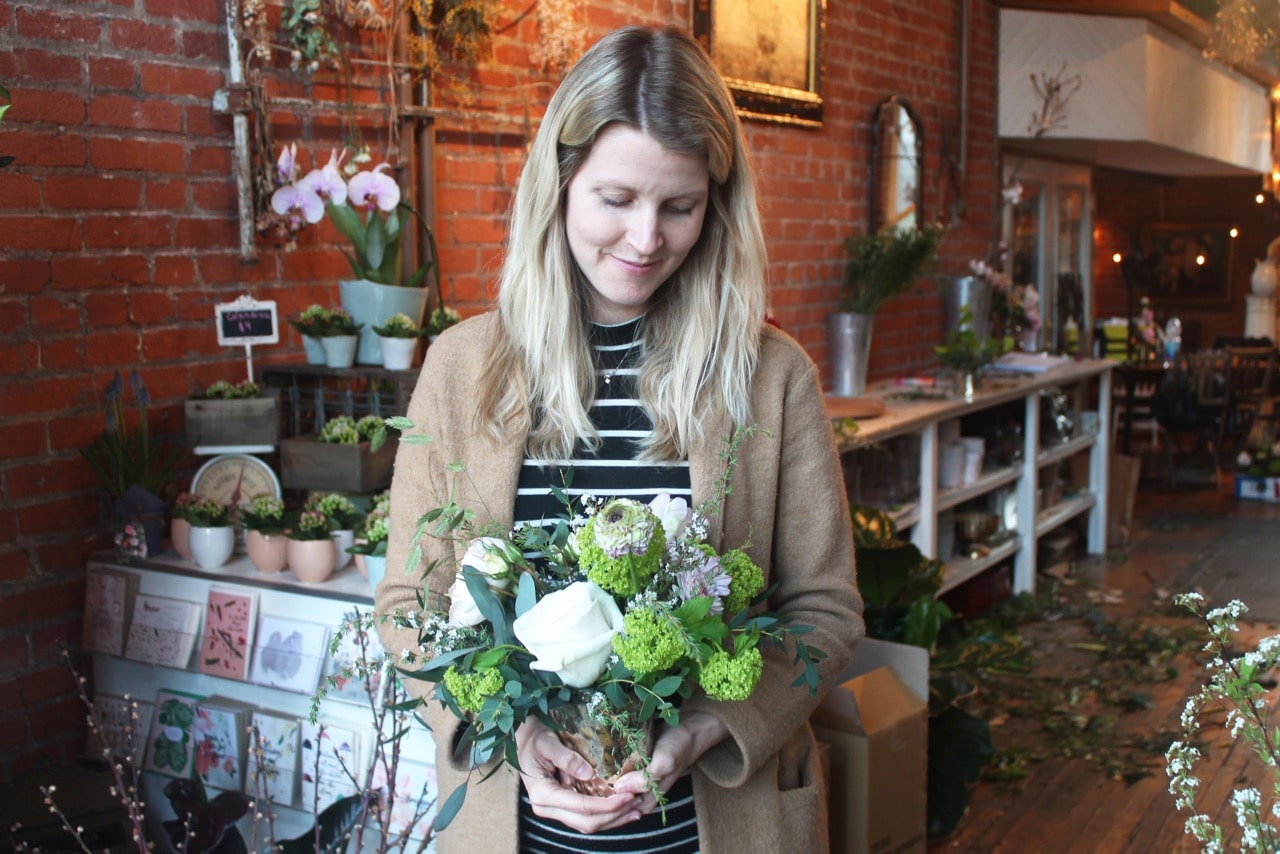Alison Westlake’s love affair with flowers began way back. Growing up between Toronto and the Ontario countryside, she got the best of both worlds. Influenced by her mom’s approach to nature, a young Alison would watch as she cut wildflowers and display them in Mason jars—long before it was a cool thing to do.
But becoming Toronto’s best florist wasn’t actually on her to-do list; Alison was keen to make it as an actress, bringing extra money in through various side gigs. It wasn’t until she worked in landscaping that she started to fall for flowers from a gardener’s perspective and began creating her own floral arrangements. Alison’s friends started to take note of her unique approach that reflected nature, encouraging her to start her own business. But it wasn’t until she spotted a wee space for rent in Parkdale that Alison went with her gut, snapping it up. Et voilà! Coriander Girl was suddenly born.
Fast forward a few years, and it’s safe to say that the once teeny business has more than, erm, blossomed. Now based in both Toronto and Prince Edward County—which Alison calls home full-time—Coriander Girl has led the charge in the local floral industry. So with Mother’s Day fast approaching, I sat down with Alison—a mom herself—to discuss The Flower Book (DK Publishing, 2017) and to learn how to create a stunner of an arrangement perfect for mom’s big day.
The brand new 244-page tome looks like a breezy coffee table book but is actually an in-depth guide to flowers. Ever wondered how to create that perfect floral arrangement? The Flower Book walks the budding florist through all the steps in an easy-to-digest manner. In addition to designer tips, flower lovers must-have is divvied up into seasons, pairing close-up images of individual flowers with facts (think stem height and fragrance) and how to best care for them. As Alison notes, “flipping through the book is just like taking a trip to a mini florist!”

How would you describe your style of designing?
It’s informal; it’s garden-inspired. Some might consider it rustic, but there’s definitely a classic elegance to what we make. We start with the overall structure. We use our greenery to create the base shape, then add local flowers and then add other flowers to create shape and texture and nuance. Our colour stories are really unique. I like things that are a little less in your face. I always love when someone calls and says ‘I don’t want red roses!’ I like things to be softer and a little more monochromatic looking.
As a florist, what tips from The Flower Book really spoke to you?
It’s like going to a mini florist. I love that it’s highlighting things that are growing in our climate. I love that the author Rachel Siegfried really starts from the basics—choosing the container and talking about shape. It’s very in-depth; she’s covering all the bases.
What are your thoughts on how The Flower Book discusses creating floral arrangements?
I think it’s done really well. It really celebrates each flower. When you’re looking at these arrangements it’s like you’re walking through the garden. She talks about adding a final flourish—I’ve always instinctually done that. Getting different heights and textures and creating a sense of movement. It’s done really, really well.
Were there any tips that you found particularly helpful for the amateur florist?
How she talks about conditioning and care. They’re all really helpful tools on how to keep stems alive—like searing things or how if they’re woody stems you smash them so that the stem drinks more water. How you should be stripping anything below the water line so that it doesn’t contribute to bacteria in the water. These are all really important tips for keeping your blooms lasting as long as possible. And it’s done in such a beautiful way—I’ve read books that are really in depth but not half as beautiful as this one.
What were you not expecting the book to cover?
Talking about each flower. It was unexpected to learn about each flower—the way it breaks down, how to take care of it and so on. It’s so helpful to know the meaning. ‘Anemones represent unfading love?!’ I mean, come on!
What are some of your favourites flowers to use for Mother’s Day arrangements?
Spring is the most special time for flowers. I love ranunculus. It’s the new flower, the hot flower and the number one request for weddings. I’ve always loved them—they’re so intricate and so unique. When they open they keep opening and do this papery thing with the petals.
Peonies have always been hot. I love the smell, the different colours, the hundreds of varieties… But then the David Austin garden rose is unmatched. The smell! They’re so special.
Using tips from the book, how can the budding florist make a floral arrangement for mom?
So I’m working from your basic centerpiece and the principles she talks about while working with seasonal flowers. We’re using local ranunculus—the pink and the small green—local mums, local tulips, small spray roses, and a David Austin garden rose. We’re also using some acidic green viburnum, sterling range—I saw it at the market and had to have it—quaking grass and parvifolia.

Alison starts by taping off her vase top into a lattice, as outlined in The Flower Book. She notes that the method is cost effective—you don’t have to buy as much greenery—and it keeps all the foliage in place.

She then starts to create her shape with the greenery, using the dark green parvifolia to build an asymmetrical triangular frame, noting that it’s important to off any of the greens that are going to fall below the water line. Alison also points out that it’s important to cover the mechanics behind the masterpiece (also known as the tape).

Alison begins layering in the filler foliage, starting with sterling range, which has tiny blooms, before moving to the chartreuse-hued bursts of viburnum.

She then starts to place the larger focal flowers—the pink ranunculus and the David Austin rose— into the arrangement. “You’re really just creating these lovely flowing lines—the way that flowers grow in a garden,” Alison says. Once those are placed, she moves onto the smaller focal flowers: the green ranunculus, spray roses, the local mums and tulip.

The arrangement comes to a close with the addition of some wistful quaking grass—a final flourish. “You sometimes just have to know when to quit!” Alison laughs. “You could keep going forever!”



Love Alison!! She has such a wonderful flair for floral design. Your Auntie Judy would have loved to learn from her creations as she had a heart and passion for floral arranging, as you know. I love her style of floral design and I call it “Rustic Elegance”….. so perfect for my own desire for home decorating and garden design!!
If you’re in the Parkdale area of Toronto or in Picton, make sure you visit Alison at her floral design shops, “Corainder Girl”…you won’t be disappointed!